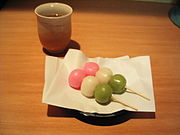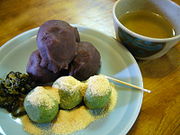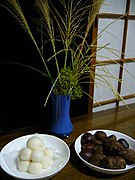Dango
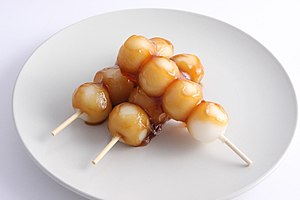 | |
| Type | Sweets,Dumpling |
|---|---|
| Place of origin | Japan |
| Main ingredients | Rice flour |
| Other information | Unicode Emoji 🍡 |
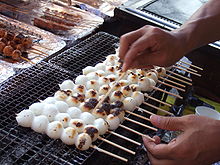
Dango(Đoàn tử)is a Japanesedumplingmade with regularrice flourandglutinous riceflour.[1]They are usually made in round shapes, and three to five pieces are served on askewer,which is calledkushi-dango(Xuyến đoàn tử).The pieces are eaten with sugar, syrup,red bean paste,and other sweeteners. Generally,dangofalls under the category ofwagashi(Japanese confectionery), and is often served withgreen tea.It is eaten year-round, but the different varieties are traditionally eaten in given seasons.Dangois sometimes compared withmochi,but is different in that mochi is generally made only with glutinous rice.
A popular type ofdango,thehanami dango,has been made into aUnicodeemoji(🍡).
Types
[edit]
The many different varieties ofdangoare usually named after the various seasonings served on or with it.[2]
Popular dango
[edit]- Ankodango(あんこ đoàn tử)is commonly covered with sweetenedred bean paste;ingredients other thanazukiare used on rare occasions. Other toppings for anko includezunda(ずんだ)made fromedamamepaste andkurumi(walnut) paste.
- Cha dango(Trà đoàn tử)isgreen tea(matcha) flavoreddango.[3]
- Shoyudango(醤 du だんご)is a kind of baked dango (yaki dango(Thiêu き đoàn tử)) and is seasoned withsoy sauce.Furthermore, the one wrapped withnoriis calledisobe dango(Cơ biên đoàn tử).
- Hanami dango(Hoa thấy だんご)also known assanshoku dango(Tam sắc đoàn tử)is eaten duringhanami.It has three colors (pink, white and green), and is traditionally made duringsakura-viewing season, hence the name (hanamimeans "flower viewing";hanameaning "flower", andmimeaning "to see" ). The order of the three colored dumplings is said to represent the order in which cherry blossoms bloom. Pink represents cherry buds, white represents cherry blossoms in full bloom, and green represents leafy cherry blossoms after they have fallen. This one was chosen for the Dango Unicode emoji, 🍡
- Kibi dango(きび đoàn tử)is made withmilletflour. This variety is prominently featured in the tale ofMomotarō,a folkloric Japanese hero, who offers the rounded ball (not skewered) to three talking animals in exchange for their aid in fighting demons.
- Kinakodango(きなこ đoàn tử)is made with toasted soy flour.
- Kusa dangooryomogi dango(Thảo đoàn tử or よもぎ đoàn tử)is mixed leaves ofyomogi,likekusa mochi.It is often covered withanko.
- Mitarashi(みたらし đoàn tử)is covered with a syrup made fromshouyu(soy sauce),sugar,andstarch.
- Sasa dango(Thế đoàn tử)is produced and eaten primarily inNiigata Prefecture.Sasa dangohas two varieties:onna dangoandotoko dango.Onna dango(literally "female dango" ) is filled withanko,while theotoko dango(literally "male dango" ) is filled withkinpira.Thedangois wrapped in leaves ofsasafor the purpose of preservation.
- Shiratama dango(Bạch ngọc だんご)is eaten inanmitsuormitsumame.
- Tsukimi dango(Nguyệt thấy だんご)is white dango to eat duringTsukimi.It is traditionally made during autumnfull moon(Mid-Autumn Festival).
Various other dango
[edit]- Botchan dango(Phường っちゃん đoàn tử)has three colors. One is colored by red beans, the second by eggs, and the third by green tea.Botchan dangois a product name ofEhime’smiyagegashi,which was named afterNatsume Sōseki’s novelBotchan.
- Chichi dango(Nhũ đoàn tử)is a slightly sweet, light treat usually eaten as a dessert.
- Denpun dango(でんぷん đoàn tử)fromHokkaidois made frompotato flourand baked with sweet boiled beans.
- Kuri dango(Lật だんご)is coated in chestnut paste.
- Niku dango(Thịt đoàn tử)is a type of Japanesemeatball.[4]Chickenniku dangois calledtsukune,served on askewer.
Derived terms
[edit]A commonJapanese proverb"hana yori dango"(Hoa より đoàn tử,literally, "dango rather than flowers" )refers to a preference for practical things rather than aesthetics.
Ahairstyleconsisting ofdango-like buns on either side of the head is sometimes known asodango.
Dorodangois a Japanese art form in which earth and water are molded to create a delicate, shiny sphere, resembling a billiard ball.
In Vietnam
[edit]Bánh hònis a specialty dessert ofPhan Thiet.The cake is made from tapioca flour, coconut, roasted peanuts, salt and sugar. When finished, it is rolled over shredded coconut and skewered like Japanese dango.
Unicode character
[edit]The Unicodeemojicharacter 🍡 is used to resemblehanamidango. The character was introduced in October 2010.[5]
See also
[edit]References
[edit]- ^Đại từ lâm đệ tam bản “だんご〔 đoàn tử 〕”-コトバンク2020 năm 4 nguyệt 3 ngày duyệt lãm
- ^Rachel (April 14, 2008)."Dango Digest: A Thorough Look at Japanese Dumplings, Part Two".theanimeblog.Archived fromthe originalon 2008-09-15.
- ^"Wagashi: Chadango and Minazuki".June 29, 2008.Retrieved2009-03-28.
- ^"Niku Dango - Sumo Kitchen".Sumokitchen.Retrieved21 December2017.
- ^"Unicode Character 'DANGO' (U+1F361)".Fileformat.info.Retrieved2017-03-02.

